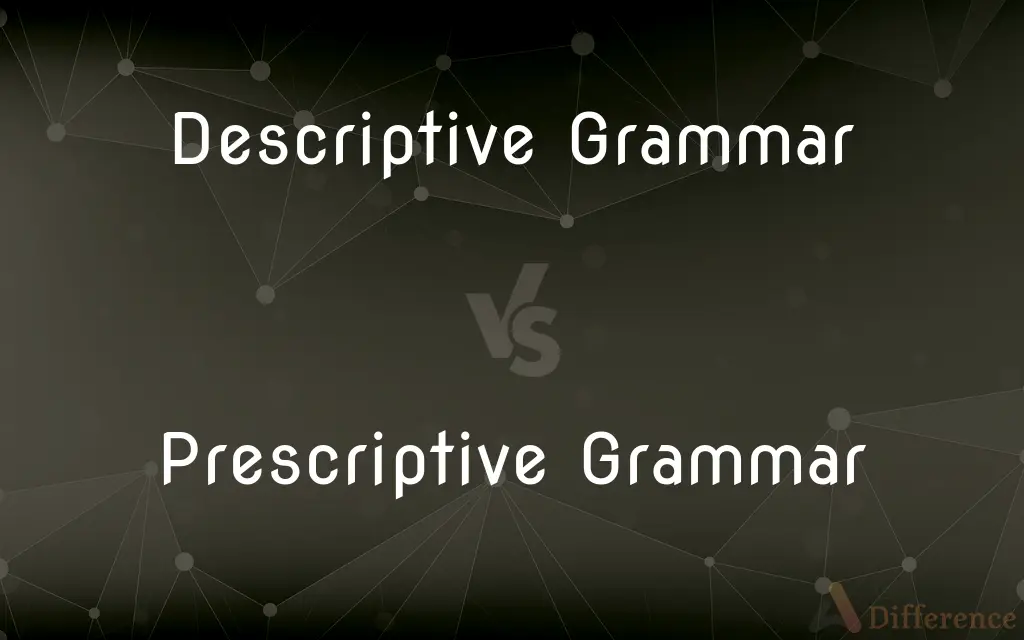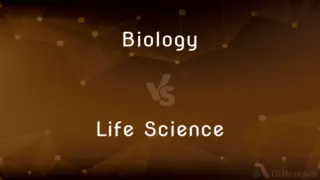Descriptive Grammar vs. Prescriptive Grammar — What's the Difference?
By Tayyaba Rehman — Published on January 4, 2024
Descriptive Grammar observes and documents language as it's naturally used. Prescriptive Grammar dictates how language "should" be used. Descriptive is observational; Prescriptive is rule-bound.

Difference Between Descriptive Grammar and Prescriptive Grammar
Table of Contents
ADVERTISEMENT
Key Differences
Descriptive Grammar and Prescriptive Grammar, both pivotal in linguistics, serve distinct purposes. Descriptive Grammar focuses on understanding and analyzing the natural use of language by people in real-time conversations. It doesn't judge or evaluate language use; it simply describes it. On the contrary, Prescriptive Grammar establishes standards and guidelines for how a language "ought" to be spoken or written. It sets rules and provides a structure for language use.
While Descriptive Grammar is like a mirror reflecting the evolving nature of language, Prescriptive Grammar can be likened to a manual instructing users on proper language application. Descriptive Grammar captures language in its raw, organic form, noting variations, evolutions, and patterns. In stark contrast, Prescriptive Grammar endeavors to maintain language consistency by setting firm boundaries and norms.
It's essential to note that neither approach is inherently superior. Descriptive Grammar aids in understanding language's natural progression and variations across different regions, social groups, and contexts. It embraces the fluidity of language. On the other hand, Prescriptive Grammar ensures clarity and mutual understanding, especially in formal settings. It fosters uniformity and helps prevent misunderstandings.
In educational settings, students often encounter both. While Descriptive Grammar provides them insights into real-world language applications, Prescriptive Grammar equips them with the tools to communicate effectively in standardized tests, official documents, and formal communications. Both are valuable in fostering language proficiency.
Comparison Chart
Nature
Observational
Rule-based
ADVERTISEMENT
Purpose
Document natural language use
Dictate correct language use
Application
Real-world language analysis
Setting language standards
Response to Language Evolution
Embraces changes
Resists changes
Focus
Actual use by speakers
Idealized standards of correctness
Compare with Definitions
Descriptive Grammar
A record of language's evolving nature.
Through Descriptive Grammar, we notice the rise of internet lingo.
Prescriptive Grammar
Dictates on avoiding language ambiguities.
Using Prescriptive Grammar, writers avoid potential misunderstandings.
Descriptive Grammar
Capturing variations in language use.
Descriptive Grammar studies showcase differences between British and American English.
Prescriptive Grammar
Norms ensuring clarity in communication.
Prescriptive Grammar emphasizes the difference between its and it's.
Descriptive Grammar
Understanding language without preset rules.
Descriptive Grammar embraces the fluidity seen in colloquial speech.
Prescriptive Grammar
A set of rules for "correct" language use.
English textbooks often rely on Prescriptive Grammar.
Descriptive Grammar
An analysis of language as it's naturally spoken.
Linguists use Descriptive Grammar to study regional dialects.
Prescriptive Grammar
Guidelines to standardize language.
Prescriptive Grammar frowns upon ending sentences with prepositions.
Descriptive Grammar
Observations of language without judgment.
Descriptive Grammar helps in understanding slang terms' origins.
Prescriptive Grammar
Standards for formal language settings.
Legal documents adhere strictly to Prescriptive Grammar.
Common Curiosities
Does Prescriptive Grammar change over time?
While resistant to change, Prescriptive Grammar can evolve based on widespread language shifts.
Which is more important: Descriptive Grammar or Prescriptive Grammar?
Neither is universally "more important"; Descriptive Grammar analyzes actual usage, while Prescriptive Grammar provides standardized rules.
Does Descriptive Grammar support slang?
Descriptive Grammar observes and documents all language forms, including slang, without judgment.
How do dictionaries fit into Descriptive vs. Prescriptive Grammar?
Modern dictionaries often blend both, documenting current usage while offering standard definitions.
Can language exist without Descriptive Grammar?
Language evolves naturally, but Descriptive Grammar helps document and understand these changes.
Why is Prescriptive Grammar critiqued?
Some believe it's too rigid, not accommodating the natural evolution of language.
Are grammar-checking tools prescriptive?
Largely, yes. They're programmed to check against established grammar rules.
Does Descriptive Grammar endorse errors in speech?
It doesn't "endorse" but rather documents language as spoken, including common non-standard forms.
Why do some educators emphasize Prescriptive Grammar?
Prescriptive Grammar offers clear standards, beneficial in formal writing and standardized testing.
Why is Descriptive Grammar essential for linguists?
It allows them to study and understand the organic evolution and diversity of language.
Can breaking Prescriptive Grammar rules lead to misunderstandings?
Not always, but it can cause confusion in formal settings where clarity is crucial.
Do style guides use Prescriptive Grammar?
Yes, style guides typically offer prescriptive advice to ensure consistency and clarity.
Is Descriptive Grammar more modern than Prescriptive Grammar?
Not necessarily, but it's more adaptive to current language trends and variations.
Can one be proficient in a language without knowing Prescriptive Grammar?
Proficiency is possible, but Prescriptive Grammar helps in formal communication and understanding standardized rules.
How do regional dialects fit into Descriptive Grammar?
Descriptive Grammar studies and documents these dialects as reflections of genuine language use.
Share Your Discovery

Previous Comparison
Biology vs. Life Science
Next Comparison
1X vs. XXLAuthor Spotlight
Written by
Tayyaba RehmanTayyaba Rehman is a distinguished writer, currently serving as a primary contributor to askdifference.com. As a researcher in semantics and etymology, Tayyaba's passion for the complexity of languages and their distinctions has found a perfect home on the platform. Tayyaba delves into the intricacies of language, distinguishing between commonly confused words and phrases, thereby providing clarity for readers worldwide.
















































